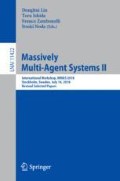Abstract
Crowd behavior has been subject of study due to its applications in fields like disaster evacuation, smart town planning and business strategic placing. However, obtaining patterns from the crowd to make a working model is difficult, as it requires an enormous quantity of data from observation and analysis and is impractical in many scenarios due to logistic and legal issues. Machine learning techniques are a good tool to overcome these difficulties, using a relatively small training data set to identify patterns, allowing crowd agents to react to similar situations accordingly. We implemented a behavioral agent model that uses such techniques into a large-scale crowd simulator, and apply inverse reinforcement learning to adjust agents’ behaviors by examples. The goal of the system is to provide to the agents a realistic behavior model and a method to orient themselves without knowing the scenario’s layout, based in learnt patterns around environment features.
Access this chapter
Tax calculation will be finalised at checkout
Purchases are for personal use only
Notes
References
Abbeel, P., Ng, A.Y.: Apprenticeship learning via inverse reinforcement learning. In: Proceedings of the Twenty-First International Conference on Machine Learning, p. 1. ACM (2004)
Alger, M.: Deep inverse reinforcement learning (2015)
Crociani, L., Lämmel, G., Vizzari, G.: Multi-scale simulation for crowd management: a case study in an urban scenario. In: Osman, N., Sierra, C. (eds.) AAMAS 2016. LNCS (LNAI), vol. 10002, pp. 147–162. Springer, Cham (2016). https://doi.org/10.1007/978-3-319-46882-2_9
Crociani, L., Vizzari, G., Yanagisawa, D., Nishinari, K., Bandini, S.: Route choice in pedestrian simulation: design and evaluation of a model based on empirical observations. Intell. Artif. 10(2), 163–182 (2016)
Dvijotham, K., Todorov, E.: Inverse optimal control with linearly-solvable MDPs. In: Proceedings of the 27th International Conference on Machine Learning (ICML 2010), pp. 335–342 (2010)
Faccin, J., Nunes, I., Bazzan, A.: Understanding the behaviour of learning-based BDI agents in the Braess’ paradox. In: Berndt, J.O., Petta, P., Unland, R. (eds.) MATES 2017. LNCS (LNAI), vol. 10413, pp. 187–204. Springer, Cham (2017). https://doi.org/10.1007/978-3-319-64798-2_12
Helbing, D., Molnar, P.: Social force model for pedestrian dynamics. Phys. Rev. E 51(5), 4282–4286 (1995)
Herman, M., Gindele, T., Wagner, J., Schmitt, F., Quignon, C., Burgard, W.: Learning high-level navigation strategies via inverse reinforcement learning: a comparative analysis. In: Kang, B.H., Bai, Q. (eds.) AI 2016. LNCS (LNAI), vol. 9992, pp. 525–534. Springer, Cham (2016). https://doi.org/10.1007/978-3-319-50127-7_45
Johansson, A., Helbing, D., Shukla, P.K.: Specification of the social force pedestrian model by evolutionary adjustment to video tracking data. Adv. Complex Syst. 10(2), 271–288 (2007). https://doi.org/10.1142/S0219525907001355
Kohjima, M., Matsubayashi, T., Sawada, H.: What-if prediction via inverse reinforcement learning. In: Proceedings of the Thirtieth International Florida Artificial Intelligence Research Society Conference, FLAIRS 2017, Marco Island, Florida, USA, 22–24 May 2017, pp. 74–79 (2017). https://aaai.org/ocs/index.php/FLAIRS/FLAIRS17/paper/view/15503
Lämmel, G., Plaue, M.: Getting out of the way: collision-avoiding pedestrian models compared to the RealWorld. In: Weidmann, U., Kirsch, U., Schreckenberg, M. (eds.) Pedestrian and Evacuation Dynamics 2012, pp. 1275–1289. Springer, Cham (2014). https://doi.org/10.1007/978-3-319-02447-9_105
Lämmel, G., Grether, D., Nagel, K.: The representation and implementation of time-dependent inundation in large-scale microscopic evacuation simulations. Transp. Res. Part C Emerg. Technol. 18(1), 84–98 (2010)
Levine, S., Popovic, Z., Koltun, V.: Nonlinear inverse reinforcement learning with Gaussian processes. In: Advances in Neural Information Processing Systems, pp. 19–27 (2011)
Luo, L., et al.: Agent-based human behavior modeling for crowd simulation. Comput. Animat. Virtual Worlds 19(3–4), 271–281 (2008)
Martinez-Gil, F., Lozano, M., Fernández, F.: Emergent behaviors and scalability for multi-agent reinforcement learning-based pedestrian models. Simul. Model. Pract. Theory 74, 117–133 (2017)
Ng, A.Y., Russell, S.J., et al.: Algorithms for inverse reinforcement learning. In: ICML, pp. 663–670 (2000)
Schadschneider, A., Klingsch, W., Klüpfel, H., Kretz, T., Rogsch, C., Seyfried, A.: Evacuation dynamics: empirical results, modeling and applications. In: Meyers, R. (ed.) Extreme Environmental Events, pp. 517–550. Springer, New York (2011). https://doi.org/10.1007/978-1-4419-7695-6_29
de Albuquerque Siebra, C., Botelho Neto, G.P.: Evolving the behavior of autonomous agents in strategic combat scenarios via sarsa reinforcement learning. In: Proceedings of the 2014 Brazilian Symposium on Computer Games and Digital Entertainment, SBGAMES 2014, Washington, DC, USA, pp. 115–122. IEEE Computer Society (2014). https://doi.org/10.1109/SBGAMES.2014.36
Šošić, A., KhudaBukhsh, W.R., Zoubir, A.M., Koeppl, H.: Inverse reinforcement learning in swarm systems. In: Proceedings of the 16th Conference on Autonomous Agents and MultiAgent Systems, pp. 1413–1421. International Foundation for Autonomous Agents and Multiagent Systems (2017)
Svetlik, M., Leonetti, M., Sinapov, J., Shah, R., Walker, N., Stone, P.: Automatic curriculum graph generation for reinforcement learning agents, November 2016. http://eprints.whiterose.ac.uk/108931/
Torrens, P.M., Nara, A., Li, X., Zhu, H., Griffin, W.A., Brown, S.B.: An extensible simulation environment and movement metrics for testing walking behavior in agent-based models. Comput. Environ. Urban Syst. 36(1), 1–17 (2012)
Yamashita, T., Soeda, S., Noda, I.: Evacuation planning assist system with network model-based pedestrian simulator. In: Yang, J.-J., Yokoo, M., Ito, T., Jin, Z., Scerri, P. (eds.) PRIMA 2009. LNCS (LNAI), vol. 5925, pp. 649–656. Springer, Heidelberg (2009). https://doi.org/10.1007/978-3-642-11161-7_52
Zanlungo, F., Ikeda, T., Kanda, T.: Social force model with explicit collision prediction. EPL (Europhys. Lett.) 93(6), 68005 (2011)
Zhong, J., Cai, W., Luo, L., Zhao, M.: Learning behavior patterns from video for agent-based crowd modeling and simulation. Auton. Agents Multi-Agent Syst. 30(5), 990–1019 (2016)
Ziebart, B.D., Maas, A.L., Bagnell, J.A., Dey, A.K.: Maximum entropy inverse reinforcement learning. In: AAAI, Chicago, IL, USA, vol. 8, pp. 1433–1438 (2008)
Author information
Authors and Affiliations
Corresponding author
Editor information
Editors and Affiliations
Rights and permissions
Copyright information
© 2019 Springer Nature Switzerland AG
About this paper
Cite this paper
Alvarez, N., Noda, I. (2019). Inverse Reinforcement Learning for Agents Behavior in a Crowd Simulator. In: Lin, D., Ishida, T., Zambonelli, F., Noda, I. (eds) Massively Multi-Agent Systems II. MMAS 2018. Lecture Notes in Computer Science(), vol 11422. Springer, Cham. https://doi.org/10.1007/978-3-030-20937-7_6
Download citation
DOI: https://doi.org/10.1007/978-3-030-20937-7_6
Published:
Publisher Name: Springer, Cham
Print ISBN: 978-3-030-20936-0
Online ISBN: 978-3-030-20937-7
eBook Packages: Computer ScienceComputer Science (R0)

